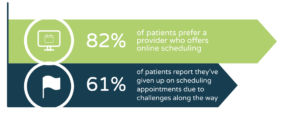3 Ways to Offset Rising Operating Costs & Medicare Reimbursement Cuts
By Chloe From Clearwave | February 28, 2024
Inflation, economic uncertainty, endless staffing shortages and Medicare payment reductions are taking a toll on physicians and their practices – and these challenges are only beginning to amplify.
An MGMA poll found that 96% of medical groups have seen their costs increase or stay the same. On top of rising costs, one recent American Medical Association (AMA) article notes, “The cost of practicing medicine is hitting a high mark for the 21st century, yet doctors are facing a 3.37% cut in pay under the proposed 2024 Medicare physician payment schedule.”
The escalating costs of running a practice combined with rising Medicare cuts have likely contributed to the 33% of physicians reporting their financial progress has declined in recent years. While these external factors are beyond your control, the good news is, you can determine how your practice responds. Here are three opportunities to set you on a faster path to revenue growth!
Three Revenue Opportunities to Offset Financial Challenges
There are proactive tactics you can take to increase realized revenue while offsetting rising operating costs and Medicare reimbursement cuts. Take these steps.
1. Identify and fix revenue leakage areas
Profit leakage throughout the revenue cycle can prevent your practice from meeting financial goals. With today’s external revenue challenges showing no signs of going away anytime soon, these are profits you can no longer afford to lose. Reducing no-shows, claim rejections and write-offs are common profit leakage areas within practices. Even minimizing one of these can make a big difference on your bottom line. Here are some tips to patch each profit leak:
No-shows: Research reveals that an average of 42% of appointments become no-shows. Another study found that each unused time slot costs physicians nearly $200, on average. It’s easy to understand, then, how non-realized revenue through no-shows and subsequent appointment gaps can add up over time to affect the bottom line.
While much of the responsibility to show up for an appointment falls on the patient, there are strategies you can take to reduce the no-show rate. One of the simplest yet most effective is sending automated appointment reminders. A big contributor to missed appointments is that patients simply forgot they had one scheduled. One report shows 1 in 3 patients missed appointments due to not having a reminder. Sending automated appointment reminders – either through email, text or voicemail – will keep visits top of mind for patients and build loyalty, so that no-show rate starts to decline. Keep in mind, not all reminder solutions are one in the same.
Use smart patient reminder tools that allow you to send follow-up reminders and customize the message notification method (voice, email, text) — all to ensure your patients get their heads up! Consider how many of your patients may miss their reminder message, because you have an old email address and didn’t call or text their phone number? Having multiple notification options and follow-up customization in your reminders tool is imperative to ensuring your patients get to your practice on time and receive the care they need.
Claim rejections: Missing and incorrect patient information due to data capture mistakes are common contributors to claim rejections. These issues happen every day and can add up, for example, when a patient’s name is misspelled, the birth date is wrong, or the insurance ID number is incorrect, a claim can’t be processed correctly. While these mistakes are small, they create big setbacks in your revenue cycle. With nearly 86% of mistakes made in the healthcare industry resulting from administrative errors, consider removing the human element in your data collection processes and instead implementing patient self-registration software that automates data capture and reconciliation.
With a self-service patient check-in system, a patient can personally scan their insurance card and license and review their existing information on filem rather than rely that information to a front-office worker to get everything right. With this automated, patient-led approach, you can get more accurate data to reduce downstream errors, minimize claim rejections and increase time-to-revenue.
Patient write-offs: With changing regulations about consumer debt and credit scores, physicians face increasing reimbursement challenges. Research reveals 45% of insured patients fail to pay their out-of-pocket bills and the probability of collecting after a patient leaves the office is 30%. As a result, practices that rely solely on front office staff to collect co-pays and past-due balances often are at risk for increased write-offs and profit loss.
Earn more at every check-in with two critical tools, multi-factor insurance eligibility verification and self-registration solutions. Without real-time insurance verification, your staff may spend hours attempting to determine patient benefits and co-pays, and still be unsure what to collect at check-in. As a result, your practice will have to send refunds, chase down $20-80 co-pays and increase write-offs. Stop this profit leakage with a solution that will determine patient responsibility, even for self-pay and Medicaid patients, in real-time so you can collect accurate amounts at every check-in.
Top-earning physicians rely on digital self-registration solutions to remove the human element from the collections process and instead automate patient collections during check-in. As a result, patients can privately be prompted to pay their co-pays and outstanding financial responsibilities during every check-in. Using this strategy, you can increase patients’ propensity to pay, which means you get paid for services rendered – and rightly so!
2. Unlock hidden profit potential at check-in
There are a variety of ways you can increase earnings at key patient touchpoints. Collecting co-pays and past-due balances at check-in is one of them. Another is boosting awareness and bookings for your premium services.

To get patients to sign up for premium services, practices often delegate the responsibility to front desk workers or rely on traditional advertising methods. While these strategies can be effective, they each come with drawbacks. Front desk employees already have a full plate, so they may not get around to gauging patients’ interest in premium services. Even if they have the time, they may feel uncomfortable asking a patient about sensitive topics (e.g., Botox) – not to mention, doing so can come across as offensive to patients who may not be thinking about certain cosmetic services.
On the flip side, taking the advertising route can quickly become costly. Even though you may be running ads that target a certain patient demographic, if you’re using campaigns to attract new patients, there is no guarantee that you’ll receive quality leads.
Top-performing physicians are modernizing their approach to promoting premium services by using targeted patient check-in workflows. They simply embed custom questions about premium services into their check-in workflows. Promoting premium services at check-in is valuable for a few reasons:
- Patients are made aware of premium services at a time when they are giving your practice their full attention.
- Because digital check-in provides a self-service option for patients, front office workers are removed from the equation, meaning patients may answer more honestly.
- You can focus on educating your patients about their options, rather than selling to them. Continuing with the Botox example, a dermatology patient might check in for an annual skin-care exam and see a question such as, “Would you like to learn about Botox services?”
Smart digital check-in tools will also allow you to tailor your workflows to ensure custom questions are only asked to the correct patient demographics. For example, since Botox typically is marketed to women between the ages of 30 and 50, only patients falling within this demographic would be asked if they’d like to learn more about Botox. By targeting patients who are most likely to book premium services, you’ll not only be more successful, but you’ll also reduce the risk of offending patients.
Promoting premium services with targeted digital messaging during the check-in process is a great way to unlock hidden revenue potential without spending a single dollar on ad campaigns. It’s a proven way to help you and your practice significantly increase premium service revenue streams.
3. Offer 24/7 online scheduling
Research shows patients prefer a provider who offers online scheduling. In this reality, the scheduling methods you offer can have a significant impact on patient acquisition, retention and overall revenue.
To meet patient expectations, many practices are now offering 24/7 online scheduling that allows patients to book on weekends, after hours or during the day when front-desk staff is dealing with heavy phone traffic. With self-scheduling, you can capture patients who may have been too busy during the day to call an office or those who aren’t comfortable discussing their situation over the phone with others around. You also can set your practice apart from others that only offer phone scheduling.
In addition to maximizing bookings for non-urgent appointments, online scheduling can help you fill last-minute appointment slots, which increases patient throughput while building loyalty with patients who have pressing healthcare needs. Practices with online scheduling have seen 45% of appointments made after hours and 61% made at the last minute.
Additional benefits of online scheduling include:
- Improved scheduling accuracy and efficiency, as technology can’t stray from pre-determined workflows.
- Reduced phone hold times as scheduling-related inquiries can be diverted online, keeping patients happy.
- A better work balance for front-office staff who are relieved from the burden of schedule management.
Overall, giving patients easier access to schedule and manage their healthcare appointments can have a profound impact on your patients and your bottom line.
Prepare for the Top Trends Healthcare Physicians Will Face in 2024
In the face of major financial challenges, physicians need to be proactive to capture revenue at every patient touchpoint. Ensuring steady cash flow in your practice is the best way to overcome rising operating costs and Medicare budget cuts.
With the cost of treating patients on the rise, top-earning physicians plan to get ahead by addressing upcoming challenges with forward-thinking action. See the top 6 trends that could impact your ability to provide quality care and protect your bottom line in 2024.
Recommended for you
Related Posts
Orthopeadic Practice Launches Patient-Centric Estimations — Increasing Self-Pay Collections
Reading Time: 3 minutesBy Blakely Roth | February 26, 2025 Concord Orthopaedics, a leader in orthopaedic care across New Hampshire, implemented a patient…
Clearwave Announces 2024 clearwaveCup Winners, Celebrating Excellence in Patient Engagement
Reading Time: 3 minutesATLANTA – February 25, 2025 – Clearwave, the patient-led self-service solution provider, is proud to announce the recipients of the…
Top 2 Trends Impacting Orthopedic Practices & Patients in 2025
Reading Time: 5 minutesBy Chloe From Clearwave | February 20, 2025 In 2025, orthopedic practices face the dual challenge of integrating high-cost technologies…





